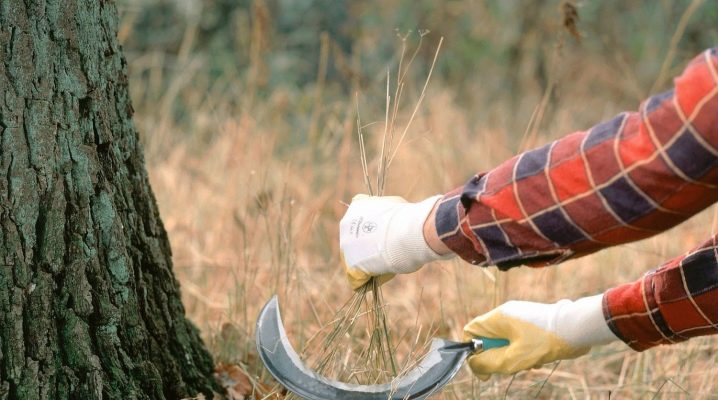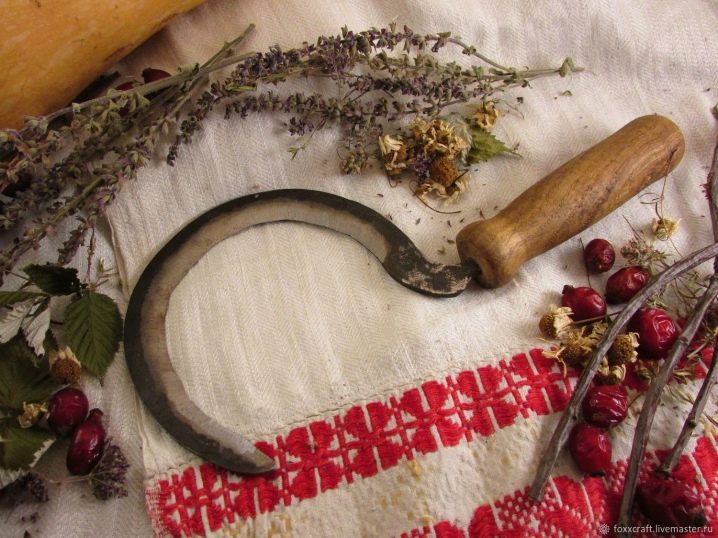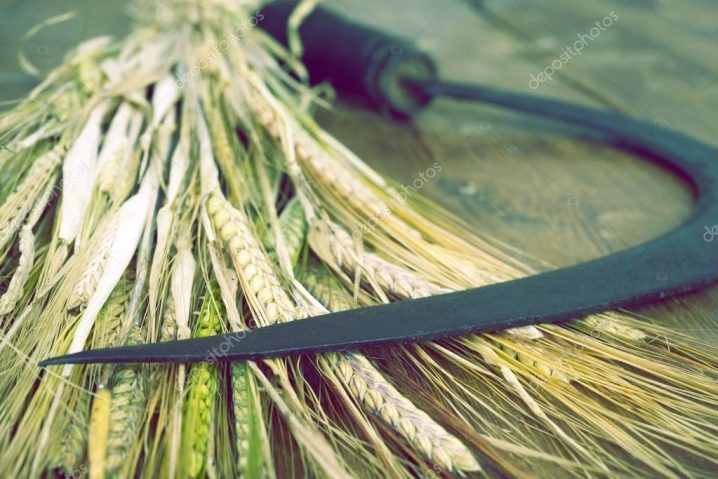Sickle: what is it, purpose and rules of work

The sickle is one of the oldest agricultural tools.It is a kind of a knife with a reverse bend, it has been used since ancient times for harvesting cereals and preparing feed for livestock. The antiquity of the tool is also confirmed by indirect data, for example, a comparison of the shape of the moon in some phases with the shape of this tool.


What it is?
It is customary to call a sickle a blade curved in a semicircle on the handle, designed for cutting ears or grass. You can imagine what it looks like by examining the symbolism widespread in the heraldry of socialist countries in the 20th century. Modern sickles have serrations on the blade that increase the cutting ability of the equipment.
The first sickles were made from a wooden curved stick with sharp flint blades inserted into it., archaeologists found traces of such tools in the Middle East, studies have revealed their gradual spread throughout the world along with the spread of agriculture. The wooden part was split, flat small sharp flakes were inserted into the cracks, then the whole structure was placed in water, the wood swelled and clamped the fragments of flint.


With the development of metallurgy, copper and then bronze sickles began to appear, such tools were found on the shores of the Mediterranean Sea. The sickle takes on its modern look in the 18th century. It is then that these products begin to be mass-produced. Now the sickle is a common garden tool and can be found in summer cottages. In the fields it has long been replaced by harvesters, and in the meadows - by mowers.


What is it for?
The direct purpose of the sickle is harvesting, mowing ears of grain. It was for this purpose that it was invented and improved for more than one millennium. The function of modern sickles is to mow the grass. You have to resort to the help of this ancient tool if the site is overgrown for any reason.
The trimmer with its line will not take such bushes. The scythe-Lithuanian requires certain skills when setting up, and few will be able to use it in our time. Here again, the time-tested sickle came in handy.


The teeth on the inwardly curved sickle blade sometimes cope with success even with the stiff weeds. You can also mow grass for rabbits or poultry with this tool. Narrow row spacings are also quite convenient to mow with a sickle. This tool can be used to mow grass near the trunks of garden trees and shrubs, to refine fences or hedges.
Classification
Such a long period of development of the instrument could not but affect its appearance and structure. Modern sickles can be classified according to a number of characteristics.
By the type of handle
According to the results of sales, sickles with a handle 11 cm long and 3 cm in diameter are absolutely in the lead. The handles are made of wood or plastic. A wooden handle is preferable: it does not slip or turn in the hand, does not "fear" sunlight and does not break when the instrument falls. The handle, which has dried out from time to time, can be fixed by soaking the tool in water.


By form
The length of the cutting edge of sickles varies from 25 cm to 50 cm. Accordingly, the width also changes - from 4 to 6 cm. The most commonly used medium-sized tools are up to 35 cm long and weigh about 200 g.
According to the shape of the blade, all modern sickles are divided into three groups.
- The herbal sickle, designed for harvesting grass, has a smooth, without teeth, semicircular blade 4 cm wide.
- The classic sickle with a tapered end and serrated blade was intended for harvesting crops. This form remains the most popular to date.
- The reinforced sickle has a classic shape, but differs in greater thickness and overall weight. It is a versatile tool that can be used from harvesting to cutting bushes.



By blade material
Steel is used for the manufacture of modern garden tools, but its quality is different. For irregular and small-scale work, ordinary steel is quite suitable. But tools that have to work hard must be made of more expensive hardened steel. For a multi-day harvest, such a high-quality sickle would probably be important, but there is practically no such work in modern summer cottages. You can find stainless steel products on sale, but, apart from an attractive appearance, they have no other advantages, despite the high price.

How to work with him?
The technique of working with the sickle has been perfected for a long time. The sickle harvest has been described in many literary works, immortalized in the works of artists illustrating this process.
The peculiarities of the technique are determined by the presence or absence of teeth on the sickle blade. The grass is cut with a smooth blade, and sawn with a serrated blade. In the second case, the capabilities of the tool are much wider. The smooth herbal sickle is suitable for harvesting succulent herbs. It will not work for dry or lignified vegetation.
The sickle, which has a strongly curved shape, did not appear by chance, it helped to distribute the force over the entire surface. Thus, the effort of the reaper was distributed evenly, and it was possible to work practically without stopping, only with short breaks, during the whole daylight hours. Cleaning about 150 square meters per hour was considered the norm.


The process of working with the tool can be divided into three stages.
- Separating part of the plant stems with the pointed end of the blade.
- Grasping separated stems with the left hand at about mid-length.
- Cutting off the stems captured in a bunch. The movement should be smooth, without sudden jerks, this will not speed up the work at all, it will only require unnecessary energy from the mower.


The cut grass or other plants do not fly away, as when working with a trimmer, but remain in the hand and can be laid down as required. A serious drawback of working with a sickle is the constantly bent back of the worker, this factor once became an important incentive for the creation of a pink salmon braid - a kind of sickle on a long handle, and then a cast braid, with which it became unnecessary to bend at all.
The sickle is a rather dangerous tool. In unskillful hands, he is capable of inflicting a serious stab or cut wound, first of all, to the mower himself. Since ancient times, in many countries, the sickle, along with the flail or ax, has been a weapon of the peasant militia. To avoid injury, mowing is recommended only when the body is in a comfortable position, when the blade is visible and its position is known.

Care Tips
- The serrated blade of the sickle does not need to be sharpened; over time, it becomes thinner and becomes even sharper with some weight reduction.
- A flat blade is more demanding to maintain. Before starting work, it must be properly sharpened. In some cases, the sickle blade is beaten off like a scythe. This requires an anvil and a special hammer.

A hand-held whetstone will help to bring the blade to condition. Sharpening should be done in short strokes along the blade, turning it away from you, pressing the handle to your chest and gradually turning as the work progresses.
- At the end of the work, the blade must be carefully wiped, you can do this with a bunch of cut grass so that there are no parts of plants or earth left, they can cause corrosion. You need to store the sickle in a suspended state, for example, on a wall, so that all its parts, including the handle, dry quickly after contact with plant juices.

For information on how to use the sickle, see the next video.



































































The comment was sent successfully.